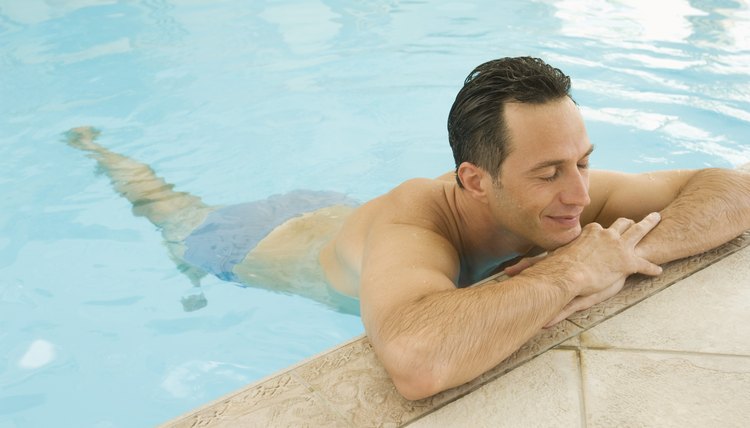How to Swim With Elbow Tendonitis

Tendonitis involves the inflammation of a tendon and its surrounding ligaments, often because of overuse. Tendonitis on the outside of the elbow is called tennis elbow; tendonitis on the inside of the elbow is called golfer's elbow. The first phase of treatment for tendonitis is rest, so if you have tennis or golfer's elbow, don't swim until your elbow is free of pain. When you resume swimming, let your body be your guide: if it hurts, don't do it.
Take an over-the-counter anti-inflammatory medication before swimming. This helps protect your tendon from swelling while you exercise.
Consult a trainer about modifications to your swimming technique. Until you are fully healed, you should avoid putting much pressure on your elbow. A swim trainer can help you make changes that will protect your injured joint.
Stretch your wrist and elbow gently before you enter the pool. Stretching helps you maintain flexibility and reduces your risk of reinjuring yourself.
Return to swimming carefully and gently. Build strength in the injured elbow slowly, without rushing yourself. If a stroke hurts, stop doing it.
Stretch again when you exit the pool. Elongate the muscles and tendon to prevent inflammation and stiffness.
Tips
Ice your elbow if it hurts. Apply ice wrapped in a towel for 15 to 20 minutes as often as needed. Protect your elbow during everyday activities by wearing a brace or forearm strap. Get your doctor's approval before returning to swimming.
Warnings
Swimming with a painful injury can worsen your symptoms and delay your recovery. Don't swim if it hurts.
References
- UpToDate: Patient Information: Elbow Tendinopathy (Tennis and Golf Elbow) (Beyond the Basics)
- American Academy of Orthopedic Surgeons. Tennis Elbow (Lateral Epicondylitis). 2015.
- American Society for Surgery of the Hand. Tennis Elbow - Lateral Epicondylitis. 2017.
- Kane SF, Lynch JH, Taylor JC. Evaluation of Elbow Pain in Adults. Am Fam Physician. 2014;89(8):649-657.
- Calfee RP, Patel A, DaSilva MF, Akelman E. Management of lateral epicondylitis: current concepts. J Am Acad Orthop Surg. 2008;16(1):19-29. doi:10.5435/00124635-200801000-00004
- Javed M, Mustafa S, Boyle S, Scott F. Elbow pain: a guide to assessment and management in primary care. Br J Gen Pract. 2015;65(640):610-612. doi:10.3399/bjgp15X687625
- Dines JS et al. Tennis injuries: epidemiology, pathophysiology, and treatment. J Am Acad Orthop Surg. 2015 Mar;23(3):181-9. doi:10.5435/JAAOS-D-13-00148
Tips
- Ice your elbow if it hurts. Apply ice wrapped in a towel for 15 to 20 minutes as often as needed.
- Protect your elbow during everyday activities by wearing a brace or forearm strap.
- Get your doctor's approval before returning to swimming.
Warnings
- Swimming with a painful injury can worsen your symptoms and delay your recovery. Don't swim if it hurts.
Writer Bio
Stephanie Mitchell is a professional writer who has authored websites and articles for real estate agents, self-help coaches and casting directors. Mitchell also regularly edits websites, business correspondence, resumes and full-length manuscripts. She graduated from Syracuse University in 2007 with a Bachelor of Fine Arts in musical theater.
